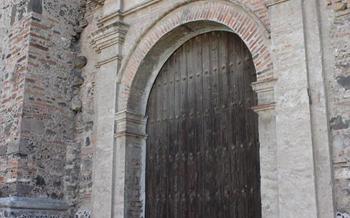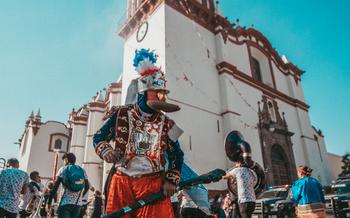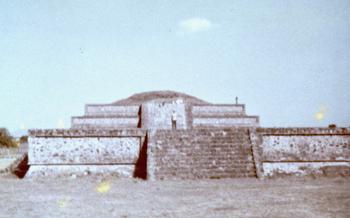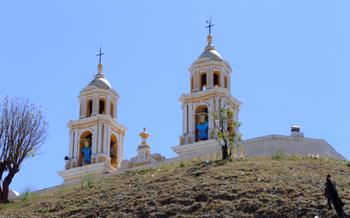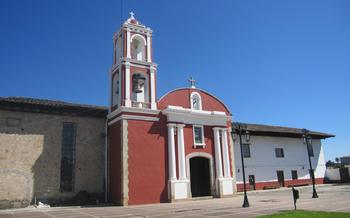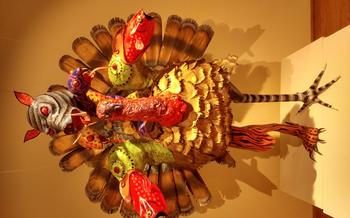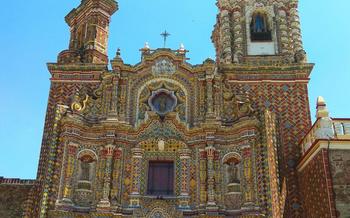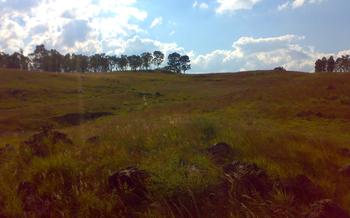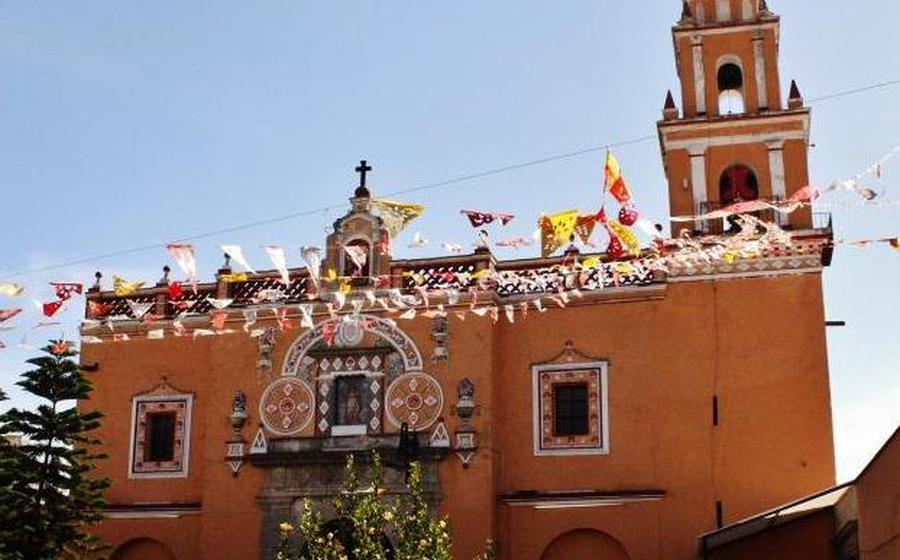
Plaza de la Danza
- Historical Significance
- The Great Pyramid of Cholula
- The Church of Our Lady of Remedies
- The Plaza's Unique Atmosphere
- Exploring the Plaza
- The Municipal Palace
- The Casa del Caballero Águila
- The Museo de la Talavera
- The Artisan Market
- The Parque Soria
- The Museo Regional de Cholula: A Journey Through Time
- The Convento de San Gabriel
- Zona Arqueológica de Cholula: Un viaje al pasado
- For an Immersive Experience: Join the Danza de los Voladores
Historical Significance
Cholula, an ancient city in Mexico, predates the arrival of the Spanish conquistadors by centuries. Its origins can be traced back to the pre-Columbian era, when it served as a significant religious and cultural center for various Mesoamerican civilizations, including the Olmecs, Toltecs, and Aztecs. The Plaza de la Danza, the heart of Cholula, holds immense historical significance as it was the site of numerous religious ceremonies and rituals conducted by these ancient civilizations. With the arrival of the Spanish in the 16th century, the plaza underwent significant transformations, including the construction of the Church of Our Lady of Remedies, which became a symbol of the Spanish colonial era. Today, the Plaza de la Danza stands as a testament to Cholula's rich and diverse history, blending pre-Columbian and colonial influences into a captivating fusion of cultures.
The Great Pyramid of Cholula
In the heart of Cholula, a colossal mound shrouded in lush vegetation rises majestically, known as the Great Pyramid of Cholula. This awe-inspiring structure, also referred to as Tlachihualtepetl, holds the distinction of being the largest pyramid in the world by volume, eclipsing even the grandeur of the Great Pyramid of Giza. Its sheer size and presence have captivated the imaginations of travelers and historians alike, making it a must-see destination for anyone visiting Cholula.
Constructed over several centuries by the ancient Cholultecas, the pyramid's origins are shrouded in mystery. Its construction involved the stacking of layers of adobe bricks, creating a massive structure that once soared over 60 meters in height. The pyramid's base measures an impressive 450 by 450 meters, covering an area larger than the Great Pyramid of Giza.
The pyramid's significance extends beyond its physical dimensions. It was a sacred site for the ancient Cholultecas, who believed it to be the resting place of Quetzalcoatl, the feathered serpent god. According to legend, Quetzalcoatl descended from the heavens and landed on the pyramid, bringing with him knowledge and prosperity. The pyramid became a pilgrimage site, attracting devotees from far and wide to pay homage to Quetzalcoatl.
In the 16th century, the Spanish conquistadors arrived in Cholula and were astounded by the size and grandeur of the pyramid. They mistakenly believed it to be a natural hill and, in their zeal to assert their dominance, built a church atop the pyramid, dedicating it to Our Lady of Remedies. This act of desecration forever altered the pyramid's appearance, but it also preserved its structure, allowing it to survive to this day.
In recent years, extensive archaeological excavations and restoration efforts have been undertaken to uncover the secrets of the Great Pyramid of Cholula. Tunnels and passageways have been discovered, revealing hidden chambers and shedding light on the pyramid's construction techniques and religious significance. Visitors can now explore these tunnels and gain a deeper understanding of this ancient marvel.
The Church of Our Lady of Remedies
In the heart of the Plaza de la Danza stands the majestic Church of Our Lady of Remedies, a testament to the fusion of Spanish and indigenous cultures. Built atop the remains of a pre-Columbian temple dedicated to the Aztec rain god Tlaloc, this iconic church is a symbol of Cholula's rich history.
The church's construction began in 1594 and was completed in 1666, showcasing a harmonious blend of Renaissance and Baroque architectural styles. Its imposing facade features intricate carvings and sculptures depicting biblical scenes and indigenous motifs, reflecting the skillful craftsmanship of both Spanish and native artisans.
Inside, the church's grandeur continues with a richly decorated interior. The main altarpiece, a masterpiece of Baroque art, is adorned with gold leaf, intricate carvings, and paintings depicting scenes from the life of the Virgin Mary. The church also houses a revered image of the Virgin of Remedies, believed to have miraculous powers, which attracts pilgrims and devotees from all over the region.
Beyond its religious significance, the Church of Our Lady of Remedies plays a crucial role in the cultural and social fabric of Cholula. It serves as a venue for religious festivals, processions, and celebrations, bringing the community together in a vibrant display of faith and tradition.
The Plaza's Unique Atmosphere
The Plaza de la Danza is a feast for the senses, with its vibrant colors, traditional architecture, and lively atmosphere. The buildings that surround the plaza showcase a blend of indigenous and colonial styles, with intricate facades painted in bright hues of yellow, orange, and red. Street vendors line the plaza, selling everything from traditional Mexican crafts to delicious local snacks. The air is filled with the sounds of music, laughter, and the chatter of locals and tourists alike.
Despite its popularity, the plaza retains a sense of history and cultural significance. The Great Pyramid of Cholula, the largest pyramid in the world by volume, looms over the plaza, a testament to the city's pre-Columbian past. The Church of Our Lady of Remedies, with its ornate baroque facade, stands as a symbol of the city's colonial heritage. Together, these landmarks create a unique and awe-inspiring setting that transports visitors back in time.
The plaza is a gathering place for locals and tourists alike. Families come to enjoy a leisurely afternoon stroll, while friends meet up for coffee or a bite to eat. On weekends, the plaza comes alive with music, dancing, and other cultural events. It is a place where people from all walks of life come together to celebrate the rich history and vibrant culture of Cholula.
Exploring the Plaza
The best time to visit the Plaza de la Danza is during the late afternoon or evening when the sun is setting and the plaza comes alive with vibrant colors and lights. Take a leisurely stroll around the plaza, admiring the architectural details of the buildings and the colorful murals depicting scenes from Cholula's history. Stop by the many street vendors to sample local delicacies such as freshly made tortillas, tamales, and traditional sweets.
Be sure to visit the Church of Our Lady of Remedies, which dominates the plaza with its impressive size and ornate façade. Climb the bell tower for panoramic views of the city and the surrounding countryside. Afterward, visit the Museo de la Talavera to learn about the history and production of Talavera pottery, a traditional ceramic art form that is synonymous with Cholula.
Take some time to simply relax on one of the benches in the plaza, people-watch, and soak up the lively atmosphere. The Plaza de la Danza is a great place to interact with locals and fellow travelers, and to learn about the rich culture and traditions of Cholula.
The Municipal Palace
The Municipal Palace (Palacio Municipal) stands as a testament to Cholula's rich history and cultural heritage. Built in the 16th century, the palace served as the seat of local government during the colonial era. Today, it continues to house the municipal offices and is a prominent landmark in the city.
The Municipal Palace boasts an impressive architectural style that blends Renaissance and Baroque elements. Its facade is adorned with intricate carvings, arches, and a central tower that offers panoramic views of Cholula. Inside, the palace features a series of beautifully preserved courtyards, halls, and chambers, each with its own unique charm.
Beyond its administrative functions, the Municipal Palace serves as a vibrant cultural center. It regularly hosts art exhibitions, concerts, and other cultural events that showcase the diverse talents of Cholula's artists and performers. The palace also houses a small museum dedicated to the history of the city, providing visitors with a deeper understanding of Cholula's past.
As you explore the Municipal Palace, be sure to take note of its exquisite details, such as the intricately carved wooden doors, the colorful tilework, and the grand staircase that leads to the upper floors. This architectural gem is a must-see for anyone interested in the history, culture, and architecture of Cholula.
The Casa del Caballero Águila
The Casa del Caballero Águila is one of the most emblematic buildings in the Plaza de la Danza. Built in the 16th century, it was the home of Captain Gonzalo de Sandoval, one of Hernán Cortés's most trusted lieutenants. The house is a beautiful example of colonial architecture, with its whitewashed walls, red tile roof, and intricate stone carvings. It is currently a museum that showcases the history of Cholula and the role of the Spanish conquistadors. Visitors can admire the well-preserved interior, which includes a central courtyard, a grand staircase, and several rooms that display artifacts from the colonial period. The Casa del Caballero Águila is a must-see for anyone interested in the history and culture of Cholula.
The Museo de la Talavera
The Museo de la Talavera is a must-visit for anyone interested in the history and culture of Cholula. The museum is located in the heart of the city, just a few blocks from the Plaza de la Danza. It houses a vast collection of Talavera pottery, which is a type of majolica pottery that is produced in the region.
The museum's collection includes pieces from the 16th century to the present day. Visitors can learn about the history of Talavera pottery, the different techniques used to create it, and the symbolism of the designs. The museum also offers workshops and demonstrations, so visitors can try their hand at making their own Talavera pottery.
The Museo de la Talavera is a great place to learn about the rich cultural heritage of Cholula. It is also a great place to find unique souvenirs and gifts. The museum is open Tuesday through Sunday from 10am to 5pm. Admission is free.
The Artisan Market
The Cholula Artisan Market is a vibrant and colorful display of traditional Mexican crafts and souvenirs. Located in the heart of the city, the market is a treasure trove of handmade goods, from intricate pottery and woven textiles to colorful glasswork and intricate silver jewelry.
Strolling through the market is a delight for the senses. The air is filled with the sounds of vendors calling out their wares, the smell of traditional Mexican spices and incense, and the vibrant colors of the handmade goods.
The variety of crafts on display is astounding. Visitors can find everything from hand-painted Talavera pottery to intricate woven baskets, embroidered textiles, and delicate glass figurines. There are also a variety of traditional Mexican clothing items, such as colorful blouses, skirts, and ponchos.
The Artisan Market is a great place to meet and interact with local artisans. Many of the vendors are happy to share the stories behind their crafts and demonstrate their techniques. Visitors can learn about the history and traditions of Mexican artesanato while supporting local craftspeople and taking home a unique souvenir of their trip to Cholula.
When shopping at the Artisan Market, it's important to remember that bargaining is expected. Don't be afraid to haggle with the vendors to get the best price. However, always be respectful and polite, and remember that the vendors are making a living from their craft.
Must-try local foods and drinks:
- Cemitas: A traditional Mexican sandwich made with a sesame seed bun, pulled pork, avocado, and various other toppings.
- Chiles en nogada: Poblano peppers stuffed with minced meat, fruits, and nuts, and covered in a walnut sauce.
- Talavera pottery: Colorful and intricate pottery made in the Talavera de Puebla style.
- Pulque: A traditional Mexican alcoholic beverage made from fermented agave sap.
The Parque Soria
A Haven of Tranquility and Recreation Amidst Historical Charm
The Parque Soria, a verdant expanse nestled in the heart of Cholula, serves as a tranquil oasis, offering respite from the bustling city streets. Once the estate of a wealthy Spaniard, this enchanting park is imbued with historical significance and natural beauty.
Named after its former owner, Don Manuel Soria y Ortega, the park was donated to the city in 1938, transforming it into a beloved public space. Over the years, it has undergone renovations and expansions, evolving into a modern park while retaining its historical charm.
Visitors to the Parque Soria are greeted by a picturesque sight: lush green lawns, towering trees, and a serene pond teeming with aquatic life. The park's meticulously landscaped gardens burst with vibrant colors, creating a feast for the eyes.
Families flock to the Parque Soria to enjoy its array of amenities. Children delight in the playgrounds, while adults can unwind on park benches or embark on leisurely strolls along the winding paths. The park also features a basketball court, a skating rink, and a theater, hosting cultural events and performances throughout the year.
The Parque Soria is a testament to Cholula's commitment to preserving its green spaces while honoring its rich heritage. It serves as a sanctuary for locals and tourists alike, offering a tranquil escape from the urban hustle and bustle, a place to recharge, relax, and reconnect with nature.
The Museo Regional de Cholula: A Journey Through Time
The Museo Regional de Cholula stands as a testament to the rich cultural heritage and captivating history of this ancient city. Established in 1965, the museum occupies a beautifully restored colonial building, inviting visitors to embark on a journey through time and discover the diverse narratives that have shaped Cholula's identity.
Within its walls, the Museo Regional de Cholula houses an extensive collection of artifacts, each piece carefully curated to tell a unique story. From pre-Columbian pottery and stone tools to colonial-era paintings and religious objects, the museum offers a glimpse into the lives and traditions of Cholula's inhabitants throughout the centuries.
Exhibits and dioramas bring to life the city's storied past, showcasing the rise and fall of ancient civilizations, the impact of Spanish colonization, and the struggles and triumphs of the Mexican people. Visitors can trace the evolution of Cholula's artistic expressions, from the intricate designs of pre-Columbian ceramics to the vibrant colors and intricate details of colonial-era religious art.
The Museo Regional de Cholula is more than just a repository of artifacts; it is a place where history comes alive, where visitors can engage with the past and gain a deeper understanding of the cultural tapestry that makes Cholula so unique. Whether you're a history buff, a culture enthusiast, or simply seeking a deeper connection with this remarkable city, the Museo Regional de Cholula promises an enriching and unforgettable experience.
The Convento de San Gabriel
The Convento de San Gabriel is a beautiful and historic monastery located in the heart of Cholula. Founded by Franciscan friars in 1549, it is one of the oldest and most important religious buildings in the city. The convent is a fine example of colonial architecture, with its whitewashed walls, red-tiled roof, and intricate stone carvings.
The interior of the convent is just as impressive as the exterior. The main cloister is surrounded by a series of arches, which are decorated with colorful frescoes depicting scenes from the life of Christ. The church, which is dedicated to the Archangel Gabriel, is home to a number of valuable works of art, including a 16th-century altarpiece and a statue of the Virgin Mary that is said to have miraculous powers.
The Convento de San Gabriel is an active monastery, and it is still home to a community of Franciscan friars. The friars offer daily Mass and other religious services, and they also run a school and a clinic for the local community. The convent is open to the public, and visitors are welcome to explore the grounds and the church.
The Convento de San Gabriel is a must-see for anyone interested in the history and culture of Cholula. It is a beautiful and serene place that offers a glimpse into the city's rich past.
Zona Arqueológica de Cholula: Un viaje al pasado
The Zona Arqueológica de Cholula, located just a short distance from the Plaza de la Danza, offers a glimpse into the ancient past of this historic city. The archaeological zone encompasses the remains of several pre-Columbian settlements, including the Tlachihualtepetl pyramid, commonly known as the Great Pyramid of Cholula.
This massive structure, the largest pyramid in the world by volume, was built over several centuries by the ancient Cholultecas. The pyramid is surrounded by a complex of smaller pyramids, temples, and residential areas, providing insights into the daily life and religious practices of the ancient inhabitants of Cholula.
The archaeological zone is an active site of excavation and research, with ongoing efforts to uncover and preserve the remaining structures. Visitors can explore the site, climb the pyramid, and admire the intricate carvings and murals that adorn the buildings.
The Zona Arqueológica de Cholula is a significant site for understanding the history and culture of ancient Mesoamerica. It offers a unique opportunity to experience the grandeur of the past and marvel at the ingenuity and artistry of the ancient builders.
For an Immersive Experience: Join the Danza de los Voladores
During your visit to the Plaza de la Danza, don't miss the opportunity to witness the awe-inspiring Danza de los Voladores, or the Dance of the Flyers. This ancient Mesoamerican ritual, performed by indigenous communities throughout Mexico, is a breathtaking spectacle that combines acrobatics, music, and spirituality.
Watch in amazement as four dancers, dressed in colorful traditional attire, climb to the top of a 30-meter pole. They then attach themselves to ropes and launch themselves into the air, spinning gracefully as they descend towards the ground. The fifth dancer, known as the caporal, remains atop the pole, playing music and guiding the ritual.
The Danza de los Voladores is not just a performance; it holds deep cultural and religious significance. It represents the journey of the human soul, the connection between heaven and earth, and the cyclical nature of life. Participating in this ritual is a unique and unforgettable experience that will give you a deeper understanding of Mexico's rich indigenous heritage.

